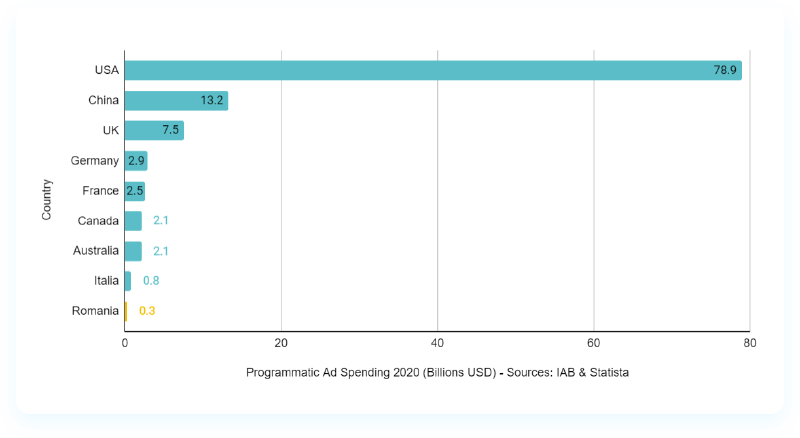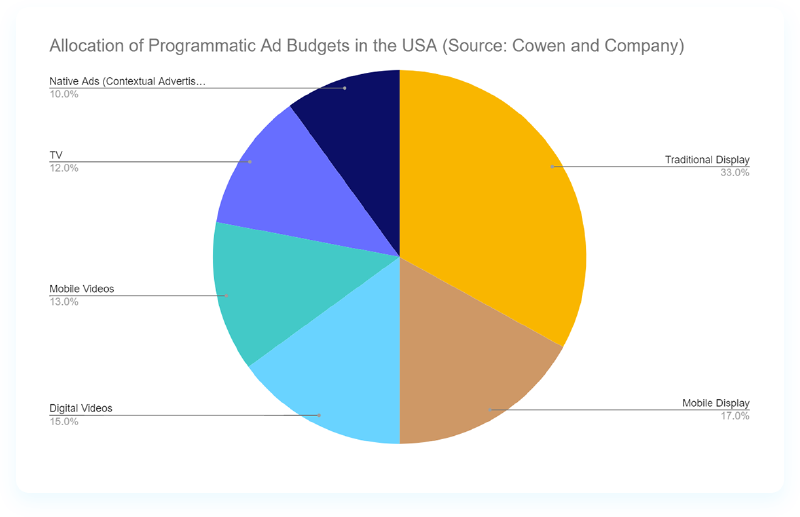
More and more businesses moving away from traditional marketing and shifting towards digital marketing favor programmatic approaches when advertising their products and services. Actually, almost 70% of all digital advertising budgets worldwide are now invested in programmatic buying.
Statista projected a global market volume of 127 billion USD for 2020 and another 20 billion increase in 2021.
Programmatic ad spending 2020 - a comparative approach (Source: IAB & Statista)

Programmatic buying refers to the acquisition of digital media in an automated manner. For example, classic PPC is considered 100% programmatic as long as buying space for advertising on Google Search, Google Maps, or Google Partners’ Network is an automated process.
But programmatic is not restricted to text ads. It goes far beyond traditional PPC and covers display ads , video ads, mobile ads, social ads, and many other formats like audio and TV.
Cowen & Company published a study in 2018 to reveal how leading marketers in the USA allocate their programmatic budgets. The display network still seems to be the top category on the list.

The process, also known as Programmatic Display Advertising, involves two main characters: the Marketer who wants to promote his products and services and the Publisher who wants to sell advertising space online.
Both the Marketer and the Publisher use ad servers to manage ads and campaigns and to organize the actual ad trade on data management platforms.
During the process, search engines like Google and YouTube allow the two main categories of participants to take advantage of available data for personalizing the ad traffic by adding context to it. For instance, if someone is looking for “organic clothes for kids,” the engines will analyze the user’s profile and serve relevant ads related to this specific query.
Marketers usually manage their ad exchanges from one interface through automated (or semi-automated) bidding on a Demand Side Platform. On the other side, the Publishers work on a supply-side platform (SSP) to put together different ad inventories. The matchmaking between the two of them is then completed in an automated marketplace.
A measurement and analysis system is integrated into the structure allowing access to real-time data for immediate optimization.
Programmatic only works if you have a brilliant strategy in place. You may need to invest time and energy in really knowing your audiences and defining intent clusters to create personalized messages for your Buyer Personas along each stage of their experience with your brand. See how Adidas is managing things with the help of Google Marketing Platform.
Once the strategy is defined, you will surely need captivating content that is supposed to be personalized and delivered to the right person, on the right channels, in the proper format, and at the right time. Let’s have a look at Campbell and its inspiring SoupTube campaign. The agency designed 1.700 versions of a video to be displayed depending on the different queries they defined as triggers during the strategic planning phase.
RTB is a mechanism for automated bidding, buying, and selling impressions. The prices for ad inventories are decided in real-time during auctions, to which all interested publishers and advertisers can participate.
With RTB, a transaction starts when someone visits a site. This simple action immediately triggers a bid request, which usually includes (when allowed) descriptive data about the user, such as demographics, location, browsing history, and landing page.
The request goes from the publisher to the ad exchange, which further submits it to different advertisers who bid in real-time. The impressions then go to the highest bidder. The entire process, including serving the ad, happens in a blink of an eye.
RTB Profi Tips
Besides fully automated RTB, there are also semi-automated mechanisms you can choose from to help you customize your media buying based on your particular needs. One of them is “Private Auction.” It works in the same way as the Open Auction, with the only difference that not all advertisers are invited to participate in the first place. The inventories are initially available only to a selected group of buyers. Just what’s left unsold is afterward made public to all other advertisers that might be interested.
If your main goal is to get in touch with a particular target group and not necessarily to reach large target audiences, you should opt for “Preferred Deals.” Based on your potential customers’ data, the mechanism can help you decide if it’s worth purchasing particular inventories from a specific publisher. Ad impressions are not guaranteed, but that’s fine as you’re focused on other objectives.
Programmatic Direct works more or less like Traditional Media Buying. It helps you reserve a specific number of impressions at a fixed price while allowing you to manage your campaigns’ frequency. It is recommended if you intend to secure a top inventory for a specific period and a fixed/pre-defined cost.
Share